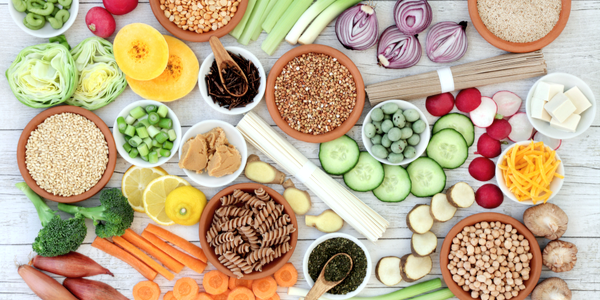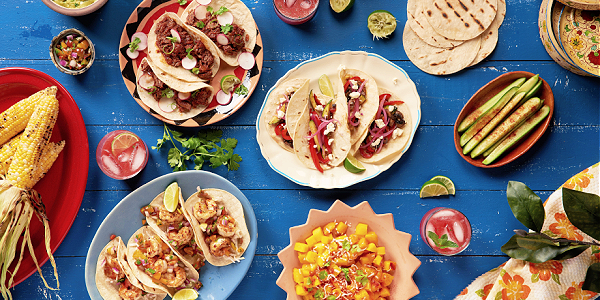
An optimal, healthy diet is based on whole grains, fruits, veggies, lean proteins, and healthy fats. These foods offer a wide array of health benefits that may help lower the risk for chronic diseases.
In the mix of that well-balanced diet, fiber adds an important role in health. Despite fiber's many health benefits, only an estimated 5 percent of Americans get an adequate daily intake of fiber.
Luckily, dietary fiber is found in a majority of nutritious foods, and it is possible to get enough daily fiber. Find out how to rise above the commonly low fiber intake with these easy ways to get more fiber in your diet as well as high-fiber diet plan ideas!
5 Easy Ways to Increase Fiber Intake
Increasing fiber does not have to be complicated. Following these easy suggestions can help bump up fiber intake and reap the health benefits of fiber, including lowering cholesterol levels, the risk of heart disease, and more.
1. Start the Day with Fiber
Healthy choices in the morning can lead to healthy choices the rest of the day. Since fiber helps with feelings of fullness, eating a high-fiber breakfast can really kick-start the day.
When choosing cereal, a general rule is 5 grams or more of fiber per serving. Oatmeal is another fabulous high-fiber breakfast choice. Adding fruit, flaxseeds, chia seeds, and wheat bran can also boost the fiber's total.
No matter what the breakfast choice, make sure to include at least a serving or two of fruits and/or vegetables. This can simply be eating apple slices on the way to work.
2. Choose Whole Grains
Over the past few years, there has been a bigger push to switch from white flours to whole grains. Unlike several health trends, going whole grain is a sustainable goal for improving health.
Switching to whole grains can amplify nutrient and fiber content. Swap white rice, white bread, or white pasta with whole grain bread, brown rice, and whole-wheat pasta.
For even more variety, use ancient grains such as barley, bulgur, quinoa, spelt, or farro for baking or as a base for salads or other mixed dishes.
3. Make High Fiber Snacks the Easy Choice
Make the most of snack time by including a fiber-rich source. Instead of grabbing a bag of chips or other processed food to munch on, reach for some fruits or vegetables. Pair with hummus or peanut butter for an ideal snack filled with protein and loaded with fiber. The combination of the two will increase satiety leaving you satisfied long after eating.
Make high fiber snacks the easy choice by cutting up and placing veggies in a storage container in the frig front and center. Do this for carrots, celery, broccoli, cauliflower, or any other favorite veggies.
The same concept can be done with fruits. Simply wash a bunch of grapes, cherries, or cut up watermelon or other fruits and place front and center in the refrigerator. Set fruits like bananas, oranges, or apples out on the counter easily seen in place of other snacks.
4. Increase Legume Consumption
Not only do legumes (black beans, kidney beans, white beans, etc.) provide ample amounts of fiber, they are an excellent, cheap source of protein. In general, reducing the amount of red meat and increasing plant-based proteins can contribute to a more healthful diet.
Dietary Guidelines recommendations for legumes include 1.5 cups of legumes per week (equivalent to 37.5 g cooked mature legumes/day) for non-vegetarians and 3 cups per week (equivalent to 75 g cooked mature legumes/day) for vegetarians.
Beans can easily be added to salads or used in place of meats in soups, burgers, tacos, or paired with whole grains for a vegetarian, protein-packed dish.
5. Fill Up the Plate with Fruits and Vegetables
To be honest, most people have a hard time eating daily fruits and vegetables. However, aim to make fruits and vegetables half the plate at meal times.
Following this guide for meals will help not only increase fiber but also increase antioxidant, vitamin and mineral intake. Adding vegetables to pasta (or in place of), soups, casseroles, sandwiches, and salads are some of the best ways to get fiber into meals.
Besides snacks and breakfasts, fruits can be a side with lunch or dinner or used as a healthy sweet end to a meal.
High Fiber Diet Plan
When increasing fiber, it is important to start slow, especially if fiber initially lacks in the diet. Along with starting slow and growing to a higher-fiber diet, maintaining adequate hydration is key to minimizing constipation.
The recommended amount of fiber is 38 grams per day for men and 25 grams per day for women. Realistically, a well-balanced diet with a variety of fiber sources can take the guesswork out of getting adequate fiber and contribute to a healthier you.
The below meals and snacks are an example of putting easy ways to increase fiber intake into practice. There are many ways to add fiber to the diet; this is just an example! Get creative with different ways to add fruits, vegetables, whole grains, nuts/seeds, and legumes to your meal plan.
High Fiber Breakfast Ideas:
• Artichoke, spinach, and roasted red pepper frittata is a high protein, veggie-packed, high fiber breakfast choice that will leave you satisfied long after eating.
• Make a high-fiber breakfast an easy choice by making overnight oats or Chia seed pudding the night before.
• Yogurt bowls can be a fun template for adding a variety of high fiber toppings- options are endless!
• Want a low-carb, high fiber way to start the day? Add in veggies and black beans to an omelet or egg scramble. Another option is to make a smoothie based on frozen fruits and leafy greens.
High Fiber Snack Ideas:
Besides fruits and veggies with nut butter or hummus, the below can also be flavorful, high fiber, and satisfying snacks.
• Apple nachos can be made in just 5 minutes and put a fun spin and change up from plain apple slices.
• Nut mixes can provide a good source of fiber but also protein and heart-healthy fats to make a nutritionally balanced and filling snack.
• Energy bites can be made from high fiber ingredients like oats, nut butter, chia seeds, and flaxseeds. Store in the refrigerator or freezer for a convenient and delicious high-fiber snack.
High Fiber Lunch or Dinner Ideas:
Packing in various plant-based fiber sources in lunch and dinner can be an easy way to get most of daily fiber recommendations. Remember, it is recommended to make veggies and fruits fill half the plate at meal times. These high-fiber lunch and dinner ideas can help boost fiber at meal times.
• Add some variety and flavor to your taste buds with a high fiber salad that mixes in vegetables, whole grains and/or legumes with a simple barley salad, barley and farro salad or white bean salad.
• Get creative with vegetable sides for dinner with cheesy broccoli cauliflower tots, zucchini fries, or mashed cauliflower with mushroom gravy.
• Make this satisfying healthy shrimp pasta that provides 9 grams of fiber per serving. Another higher fiber pasta option is to make zucchini pasta in place of regular pasta.
• Instead of bringing a ho-hum sandwich for lunch, make one of these fun Mason jar salads to bump up your lunch fiber intake.
• Try meatless meals by switching out a meat-based meal for a plant-based meal at least one time a week. For example, make a veggie burger in place of hamburgers.
In Summary on High-Fiber Diets
Not getting enough daily fiber is concerningly common for Americans. However, it can and is possible to easily increase fiber intake to daily recommendations.
One of the main factors for increasing fiber is eating more plant foods like fruits, vegetables, whole grains, legumes, nuts, and seeds. These foods provide the most fiber and should be the base for most meals and snacks.
Basing meals off these high fiber foods can ensure you are getting adequate fiber without having to meticulously track fiber on food labels.







